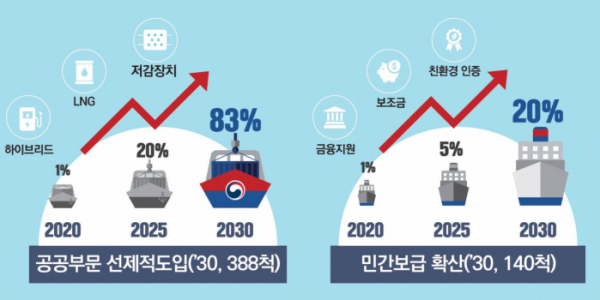▲ On the 23rd, the government decided to convert 528 ships into eco-friendly ships by 2030 through the first basic plan for developing and distributing eco-friendly ships. (Ministry of Oceans and Fisheries·Ministry of Trade, Industry and Energy)
The government has decided to reduce 400,000 tons of greenhouse gases and 3,000 tons of fine dust by converting 15% of domestic ships to eco-friendly ships by 2030. In addition, in the future, by securing carbon-free ship technologies such as hydrogen and ammonia early, plans to reduce greenhouse gases by more than 70% compared to existing oil ships will be promoted.
On the 23rd, the Ministry of Oceans and Fisheries and the Ministry of Trade, Industry and Energy announced the first basic plan for developing and distributing eco-friendly ships (2021-2030).
As the international maritime organization (IMO) strengthens greenhouse gas regulations, the global shipbuilding and shipping markets are shifting their paradigm from existing oil ships to eco-friendly ship systems. Accordingly, the government also enacted the Act on Promotion of the Development and Supply of Environment-friendly Ships in January of this year, followed by a basic plan for eco-friendly ships. In addition, the plan was named ‘2030 Greenship-K Promotion Strategy’ in order to link policies with the Green New Deal and carbon neutrality and create an image of a Korean eco-friendly ship.
In terms of the main contents, first, commercialized technologies such as LNG and hybrid will be applied first, and a total of 388 government ships will be converted into eco-friendly ships by 2030. It plans to reduce drying costs by up to 20% through standard design and integrated orders. Civilian ships also support the conversion of 140 vessels. 528 ships accounted for 15% of the total 3542 ships. The government predicted that through this, sales of 4.9 trillion won, production induction of 11 trillion won, and employment of 40,000 people could be created. In addition, it is expected to contribute to vitalizing regional economies in Busan (1.5 trillion won), Jeonnam (1.2 trillion won), Ulsan (1 trillion won), and Gyeongnam (400 billion won) where the shipbuilding and shipping industries are concentrated.
In addition, from next year to 2031, about 950 billion won was invested to localize and upgrade LNG, electricity, hybrid core equipment technology, low-carbon ship technology such as mixed fuel, and eco-friendly ship and equipment technology leading to carbon-free ship technology such as hydrogen and ammonia. Support comprehensive technology development. Through this, it plans to secure ship GHG reduction technology from 40% in 2025 to 70% in 2030.
▲ On the 23rd, the government decided to convert 528 ships into eco-friendly ships by 2030 through the first basic plan for developing and distributing eco-friendly ships. Through this, it is expected to generate sales of 4.9 trillion won, production of 11 trillion won, and employment of 40,000 people. (Ministry of Oceans and Fisheries·Ministry of Trade, Industry and Energy)
In addition, small coastal ships with eco-friendly technology are built and piloted, and then expanded to large ships. By 2022, it will build more than 10 demonstration ships, including LNG bunkering ships and LNG-ammonia mixed fuel propulsion ships by 2025. Through the construction of multi-purpose marine demonstration vessels and renovation of government ships scheduled to be retired, more than four ships will also set out on the marine demonstration test bed for equipment.
The government predicts that through this basic plan, environmental improvement effects of 1.3 trillion won can be expected by 2030. In addition, through the conversion of eco-friendly ships, it is expected that about 400,000 tons (3% of 2017’s 11.1 million tons) and about 3,000 tons of fine dust (18% of 2017’s 18936 tons) can be reduced Expected.
Deputy Minister of Oceans and Fisheries Park Jun-young said, “With the seamless implementation of the basic plan, the shipping, shipbuilding, and equipment industries will take the lead in realizing carbon neutrality in 2050 and creating a sustainable industrial ecosystem, while actively supporting development as a new growth engine that leads the new era. “He said.
